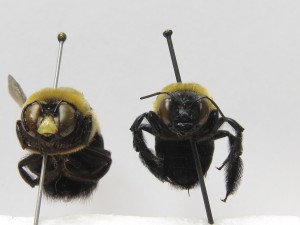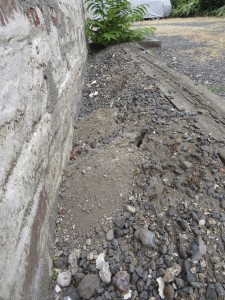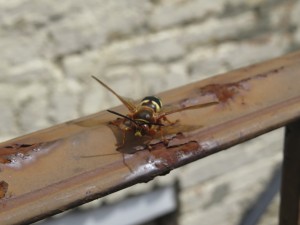The sound of buzzing in our ears is one that evokes terror. Even as an entomologist, I can only stand the sound for a short time before I involuntarily swat at my winged assailant. If this is your reaction too – know that you’re not alone. Our distress over the buzzing of a flying insect, the rattle of a snake, or the rustling of leaves may be an evolutionary response to avoid danger. But not all things that buzz are harmful!
This time of year, female carpenter bees are making nests in horizontal tree branches, flagpoles, and other wooden structures. If you happen to approach such an area, unaware of the nest-building activity, you might find yourself face to face with a large black and yellow bee. While its dive-bombing behavior may induce panic, in reality there is nothing to fear. Why? Because those obnoxious assailants are male carpenter bees, which lack a stinger and pose no real threat. Their behavior is an attempt to mate-guard, or protect females in their nesting sites. If you stand by long enough, you might observe several of these bees buzzing and tumbling with each other, and you can identify the males as those having a yellow patch on their “face”.


But male carpenter bees are not alone in their buzz-terrorizing of human intruders. Later in the year, a larger and even more intimidating insect will buzz to guard female nests. This time, however, female nests are in the ground and are marked by piles of soil. As the name implies, cicada killer wasp females capture and immobilize cicadas, which they use to provision their young. While females bare a foreboding stinger (even if they are reluctant to use it), the males are harmless and unable to sting.


So, next time you are buzzed by a male carpenter bee or cicada killer wasp – you can stand by and appreciate their complex behaviors. You can watch them fight each other for females and ultimately ignore your presence.
For more information about carpenter bees and their management, see our factsheet: Get Rid of Carpenter Bees? Yes Please!